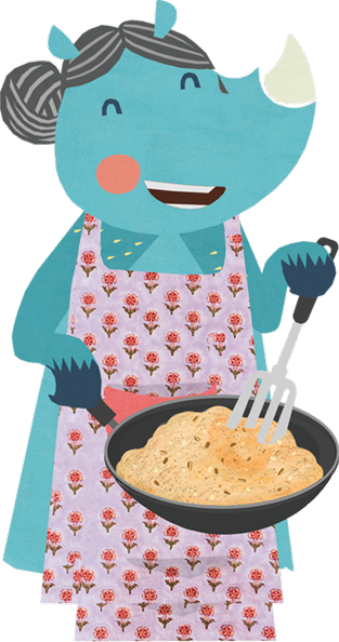Salt is a topic of concern for parents, especially because the guidelines change as your child grows. Up until 1 year of age, it's recommended to restrict salt in your baby's diet, but what about after they turn 1? Let's discuss this.
Why Controlled Salt Intake Is Key?

Salt is made up of sodium, which is a nutrient that helps maintain fluid balance, nerve function, and muscle contraction in the body. But, excessive salt intake can lead to high blood pressure or increased risks for chronic diseases. The foods your baby is exposed to at this stage will influence their future dietary choices and eating habits. Encouraging salty or sugary foods at this stage can lead to a preference for these flavors, which is not healthy in the long run.
When Can We Add Salt to Toddler's Food?
Once your baby turns 1, start adding small quantities of salt to their food. All foods contain some amount of salt naturally, even without additional seasoning.
Monitoring salt intake is more manageable when your baby primarily eats homemade meals. But, if your child sometimes eats outside or packaged foods, please keep an eye out on the “sodium” content. If it’s high in sodium, limit the quantity of food your baby has.
How Much Salt Can Toddlers Have?

For children between 1-3 years, the recommended allowance for salt is less than 1/2 teaspoon (a day).
Did you know that our bodies absorb 100% of the sodium we ingest? So when we add a small amount of salt in our food, the body efficiently absorbs it!
Why Continue to Restrict Salt Intake in Toddlers?
Sometimes, parents assume that if their baby does not like a certain dish, it’s because it’s “pheeka” or “bland.” So they think adding salt may make the dish more flavorful, thus allowing their baby to like it. But too much salt intake can have long-term health consequences; here's why:
1) Taste preferences: Babies are born with natural preferences for sweet, salty, and umami flavors. Repeated exposure to very salty foods reinforces this taste preference, potentially causing them to favor salty foods over healthier options. Processed foods, high in sodium and low in essential nutrients, can lead to unhealthy eating habits.
2) Immature kidneys: A baby's kidneys are still maturing, making it difficult for them to process large amounts of salt. Even as they enter toddlerhood, it's best to avoid excessive salt intake to prevent any damage.
High-Sodium Foods to Avoid
To keep your toddler's salt intake in check, it's important to be mindful of foods high in sodium. While occasional consumption is okay, these foods should not become a regular thing.
Here is a list of high-sodium foods:


- Instant noodles, soup powders, and instant soups
- Papadh
- Cheese

- Salted Fish

- Cold cuts and cured meats (e.g., deli meats, bacon, ham, and sausage)
- Chips and namkeen
- Frozen foods and ready-to-eat curries, gravies, and snacks
- Crackers, khari, and biscuits
- Store-bought spice blends (e.g., masala cubes and masala mixes)
- Packaged mixes for pasta and noodles
- Olives, pickles, sauerkraut, and other pickled vegetables
- Store-bought salad dressings
- Condiments like soy sauce and ketchup
- Bread and bread products
- Tomato/pasta sauces
- Canned vegetables and beans
- Cereal (meant for adults)
- French fries
How to Identify High-Sodium Foods
Taste alone may not always reveal a food's sodium content. Hence, it’s important to check the nutrition labels on the pack. When shopping for packaged foods, you can use the following reference point for understanding the level of sodium content:
LOW: 0.3 grams and below (per 100 grams)
MEDIUM: 0.3 grams to 1.5 grams (per 100 grams)
HIGH: Above 1.5 grams (per 100 grams)
How Parents Can Keep Salt Consumption Low in Toddlers
Here are some practical steps you can take to ensure that your child’s salt intake remains within healthy limits:

1) Offer home-made meals: This allows you to have control over the amount of salt added to the food. Compared to restaurant or packaged foods, homemade meals will contain less salt.
Many readymade masala powders contain extra salt for flavor enhancement, such as seasoning cubes or masalas. To minimize salt intake, opt for small quantities of typical Indian powdered spices like jeera (cumin), dhania (coriander), and haldi (turmeric) to enhance the flavor. Feel free to use small quantities of garam masala, chole masala, biryani masala, etc.
2) Mindfully balance their diet: Focus on the overall composition of your toddler's diet to achieve a balanced intake. If your child occasionally consumes high-salt foods, make a deliberate effort to ensure that other meals on the same day are low in salt. Similarly, if they indulge in a high-sodium snack, consider balancing their diet with low-sodium meals throughout the week.
3) Read and compare food labels: When selecting packaged foods, compare nutrition labels to choose lower-sodium options. [Here’s a recap to our earlier article on reading food labels.]

4) Avoid salty snacks: Try your best to limit the consumption of salty snacks (chips, wafers, namkeen, farsan, bhujiya, sev, chivda), as these items are often packed with sodium.

5) Swap the butter: Consider using unsalted butter instead of the more popular salted butter.

6) Avoid pickles and sauces: Keep your child away from pickles, sauces, and canned foods, as they often contain high sodium.
What About Other Types of Salt?
Wondering if Himalayan salt or black salt are healthier than regular table salt? While these salts contain some natural minerals, they are still primarily composed of the same amount of sodium as regular salt. So, apply the same rules to these salts as you would to regular table salt.
Regular table salt, which is fortified with iodine and iron, is a good choice for toddlers. Iodine is a vital nutrient that can be challenging to obtain through other dietary sources. Choosing iodized table salt ensures your child receives this essential nutrient.

















